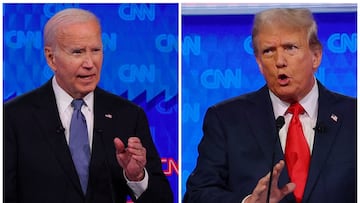US POLITICS
How many US Presidents have not sought re-election?
Only a handful of presidents have not sought re-election throughout US history. Here is the full list and the circumstances surrounding their decision.

Only a handful of presidents have not sought re-election throughout US history. This article will discuss both presidents who did not seek a second term and a more morose group who were killed or fell ill during their time in the White House and thus could not run for re-election.
Elections in the 1700s
Starting from the top, George Washington, the country’s first president, sought re-election but limited his service to two terms, setting a precedent for more than two centuries.
Elections in the 1800s
John Adams sought re-election and lost in 1800 to Thomas Jefferson, who had served as his vice president. In those days, the candidate that received the second highest number of votes automatically assumed the role. Thomas Jefferson, James Madison, and James Monroe served two consecutive terms.
John Quincy Adams tried for a second term but lost to Andrew Jackson, who would accomplish Adams’ mission.
Martin Van Buren lost re-election, but the case of his predecessor is much more tragic. William Henry Harrison won the election of 1840 but contradicted phenomena during his inauguration and died a month later.
That’s the first US President not to seek re-election.
Harrison’s VP, John Tyler, had been blacklisted by both major parties of the day, the Whigs and the Democrats. He was nominated as the nominee of the Tyler Party by his supporters, but he achieved no electoral success.
The 1844 election was ultimately won by James K. Polk, the first US President not to seek a second term. During the campaign, he committed to serving only one term and honored that promise. Polk would pass away a few months after leaving office in 1849.
That’s the second US President not to seek re-election.
Zachary Taylor won the presidency in 1948 and served until his untimely death in June of 1950.
That’s the third US President not to seek re-election.
Taylor’s VP, Millard Fillmore, ran for a second term but lost his party’s nomination to Franklin Pierce, who won the election of 1852.
Pierce would meet a fate similar to that of Fillmore, unable to secure his party’s nomination, and his bid for a second term was snatched by James Buchanan.
Buchanan had promised voters he would only seek one term as president, and he kept it.
That’s the third US President not to seek re-election.
Abraham Lincoln would seek re-election and win but was assassinated before the end of his second term in 1865. His VP Andrew Johnson was unable to secure his party’s nomination in 1968, losing to New York Governor Horatio Seymour.
Seymour lost to Civil War general Ulysses S. Grant, who served two consecutive terms.
Rutherford B. Hayes followed Grant and did not seek re-election, a promise he had made to voters.
That’s the fourth US President not to seek re-election.
James A. Garfield followed Hayes and, like some of his predecessors, died in office shortly after being elected. Garfield was inaugurated on March 4, 1881, and died in September that same year.
That’s the fifth US President not to seek re-election.
Chester A. Arthur did seek re-election but did not secure the nomination of his party. He did not campaign for James G. Blaine, and some historians believe that decision contributed to the loss of the Republicans to Democrat Grover Cleveland in 1884.
Benjamin Harrison would defeat Cleveland in 1888, though he did not win the popular vote, and won through an advantage in the electoral college. But Harrison would see his political rival return in 1892 when Cleveland secured a second term. Until Donald Trump, Cleveland was the only president to have run for the presidency after losing.
William McKinley won the election of 1896, and though he was successful in his re-election campaign, he was assassinated shortly after being sworn in for his second term on September 14, 1901.
Elections in the 1900s
Theodore Roosevelt served two consecutive terms, winning in both 1904 and 1908.
Republican William Howard Taft, would lose re-election to Democrat Woodrow Wilson, who served two terms.
Warren G. Harding, a Republican, won the election of 1920 but would die in 1923 before he had the chance to seek re-election.
That’s the sixth US President not to seek re-election.
That left an open race in 1924, which was won by Calvin Coolidge, who served through the remainder of the decade.
Herbert Hoover would serve a single term and lose re-election to Franklin Delanor Roosevelt, who defied presidential precedents by seeking re-election not once but twice.
His VP, Harry S. Truman, who took over after FDR passed away within a year of being elected to his third term, opted not to run in for another term, though he was eligible, in 1952.
That’s the seventh US President not to seek re-election.
Dwight D. Eisenhower served two consecutive terms. Then, in 1960, the youngest president in the country’s history, John F. Kennedy, won the White House. Kennedy was assassinated in 1963 and thus did not seek re-election. Though Johnson ran and won in 1964 and was eligible for another term, he opted to sit out the 1968 race.
Those are the eighth and ninth US Presidents not to seek re-election.
Though Richard Nixon did not complete two terms, he did win two elections.
Nixon’s VP, Gerald Ford, lost to Democrat Jimmy Carter in 1976. Carter would lose to Ronald Reagan, who did serve two terms, in 1980.
George HW Bush, Reagan’s VP and former head of the CIA, would win in 1988 but lost to Democrat Bill Clinton in 1992, who won re-election in 1996.
Elections in the 21st century
George W. Bush and Barack Obama served two consecutive terms. Donald Trump failed to win re-election in 2020, and at this point, though President Biden could drop out of the race, he has sought re-election.






